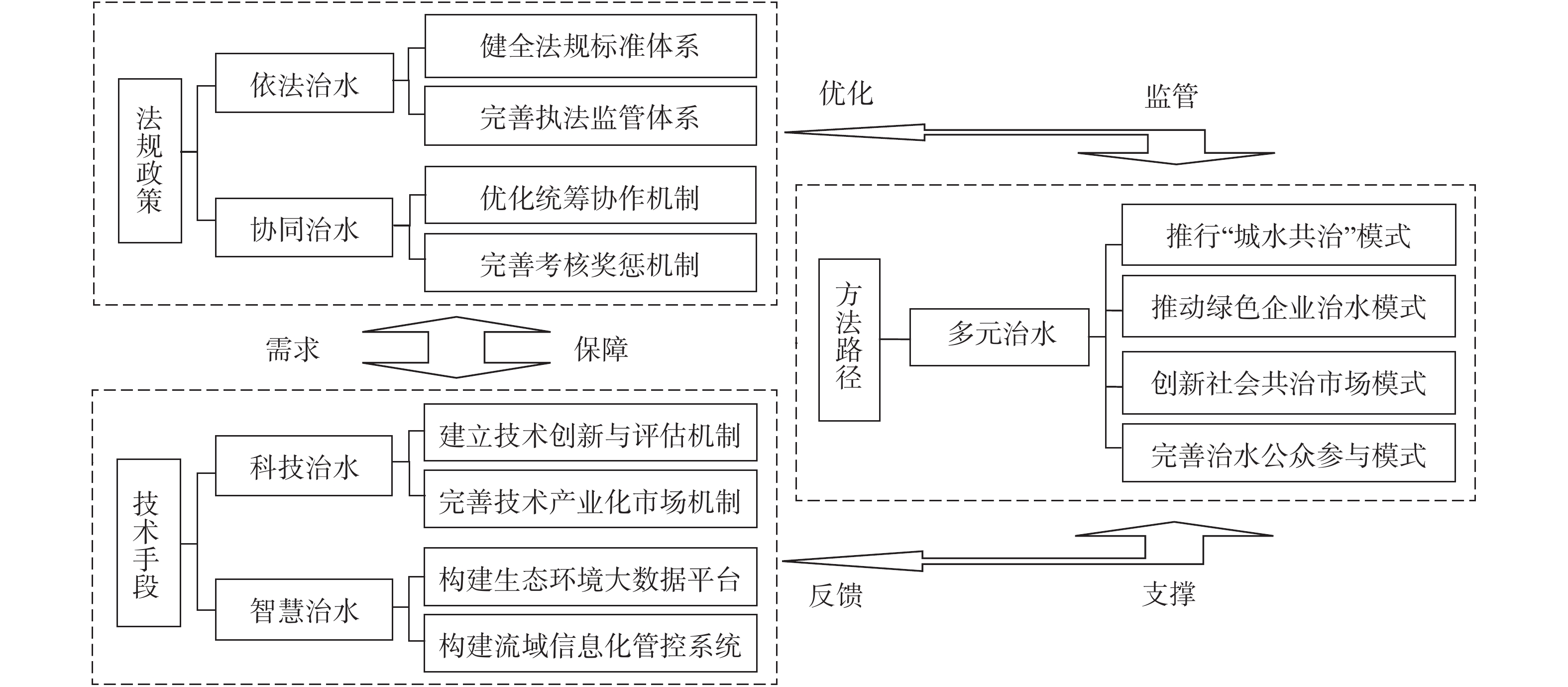-
广东省作为全国改革开放的先行者,水污染问题出现较早,水污染治理起步也较早,从1990年开始的潭江流域治理到2013年起实施的《南粤水更清行动计划》,探索了许多新的治水思路,取得了较好的治水成效[1],但与《广东省水污染防治行动计划实施方案》[2](以下称“《粤水十条》”)提出的总体要求和考核目标仍存在较大差距。为推进全省高质量发展,广东省吹响了以环境质量改善为目标的水污染防治攻坚战号角。面对繁重的水环境治理任务和紧迫的水质改善目标要求,必须在总结治水长期经验和现实短板的基础上,与时俱进,开拓创新,探索一条符合广东省省情和水情的治水新路子。
全文HTML
-
自改革开放,特别是20世纪90年代以来,广东省经济快速发展的同时也带来了日益突出的水环境问题,水体污染和由此引发的水质性缺水成为制约社会经济发展的重要因素[3]。为此,广东省探索和推行了一系列集法律、行政、经济和工程等措施在内的治水模式。
-
1998年起,广东省人大常委会先后审议通过了《广东省珠江三角洲水质保护条例》(1998年)、《广东省韩江流域水质保护条例》(2001年)、《广东省东江水系水质保护条例》(2002年)、《广东省跨行政区域河流交接断面水质保护管理条例》(2006年)、《广东省饮用水源水质保护条例》(2007年)和《广东省西江水系水质保护条例》(2017年)等多部涉水法规,构建了全省“区域+流域+要素”的水污染防治法制体系,为推动重点区域、重点流域和重点水体水环境保护提供了法制保障。
-
1997年,广东省人民政府颁布了《广东省碧水工程计划》,提出“饮用水源水质保护、城镇生活污水处理、重点工业污染源治理”为重点的区域(流域)水环境“三源”共治模式。该计划对遏制全省水环境恶化趋势,改善重点区域水环境质量起到了积极作用;2002年,广东省人民政府颁布了《广东省珠江水环境综合整治方案》,实施“统一部署、部门配合、上下游协调、区域内互动”的水污染联防联治模式,实现了区域管理与流域治理良性互动,珠江水质逐年好转;2013年,广东省环境保护主管部门印发了《南粤水更清行动计划(2013~2020年)》,形成“流域-控制区-控制单元”三级分区体系的水环境精细化管理模式。该计划成为全省“十二五”和“十三五”水污染防治的重要依据和行动指南。
-
1990年,江门市与下辖恩平、开平、台山和新会4县签署责任书,对潭江开展跨区保护,推行四地联合审批工业项目、区域水质达标交接、建立专项保护资金等措施,成为广东省第一个实施跨县界河流水质达标管理的地市,被誉为“潭江模式”。该模式树立了水质保护从各自为政向全流域保护转变的方向标;2008年,广东省人大常委会将淡水河、石马河(“两河”)污染整治建议提案作为重点督办事项,形成了一系列跨市界河流污染整治的制度和机制。“两河模式”取得明显成效,并被推广应用到广佛跨界河流、茅洲河、练江和小东江(“四河”)治理中;2014年,粤、桂两省区政府签署《粤桂九洲江流域跨界水环境保护合作协议》,明确两省区联合制定水污染防治规划,共同出资用于流域上游环境基础设施建设和污染治理工作,共同优化流域产业结构和布局,联合开展水质监测和污染治理,协同处理跨省突发水环境事件等。“九洲江模式”成为跨省界河流水污染防治的典范。
-
广东省多年来通过推行一系列治水模式,积累了宝贵的治水经验,可以总结为以下几点:①强化法制保障作用,将水污染防治工作纳入法制化轨道,构建了“区域+流域+要素”的条块式水污染防治法制体系;②坚持从区域流域整体出发,实施水污染系统防治与精准施策,形成了“一河一策、多源共治”的流域水环境治理模式;③建立监督机制,强化政府责任,走出了一条“人大监督、政府主导、部门协同、政绩考核”的流域水环境管理路径;④推动跨行政区域合作,共同解决区域重大水环境问题,建立了“定期会商、联合监测、联合执法、应急联动”的区域水污染联防联治机制。
1.1. 治水模式发展
1.1.1. 水污染防治法制模式
1.1.2. 区域/流域污染整治模式
1.1.3. 跨界河流污染整治模式
1.2. 治水经验总结
-
根据2004~2018年《广东省环境状况公报》[4],近15年来,广东省主要江河水质优良(达到或优于Ⅲ类)断面比例逐年上升,从2004年的54.1%提高到2018年的78.6%;不达标水环境功能区比例逐年下降,从2004年的52.3%下降到2018年的18.5%,2012年低至15.3%;劣Ⅴ类水质断面比例基本呈现逐年下降趋势,从2004年的17.5%下降到2018年的12.5%。2010~2017年降至10%以下;跨市界断面水质达标比例基本呈现逐年上升趋势,从2006年的64.3%提高到2017年的79.1%,2018年下降为68%;县级及以上集中式饮用水源地水质达标比例从2005年的87.5%提高到2010年的97.1%,2011年起连续多年实现100%达标。2016年出现小幅下降,为98.1%;近岸海域水质达标比例从2005年以来多年保持在90%以上,2009~2013年达到97%。2017年出现大幅下降,为73.1%,2018年降至65.7%。2004~2018年,广东省水质变化情况见图1。
由图1可见,广东省水质变化趋势总体向好,全省水环境质量改善大致经历了2004~2007年、2008~2012年和2013~2016年3个阶段,与同期推行的一系列治水模式密不可分。第一阶段主要是2002年《广东省珠江水环境综合整治方案》颁布实施后,珠江流域内各地市大力推行水污染联防联治模式,重点区域水质大幅度改善;第二阶段主要是2008年省人大监督下的“两河模式”得到应用和推广,全省重污染河流和跨市界断面水质明显改善;第三阶段主要是2013年《南粤水更清行动计划(2013~2020年)》颁布实施后,水环境精细化管理模式得到应用,全省水环境质量持续改善。
-
通过上述分析可以看出,广东省仍面临水质优良断面比例和达标水环境功能区比例不高、劣Ⅴ类水质断面比例下降幅度较小、跨市界断面水质达标比例波动较大、优质水源地比例偏低和近岸海域水质面临下降威胁等问题。同时也反映出治水模式主要存在以下几个短板:①治水法制和执法监管体系不健全。现行的条块式法规体系缺乏全局性和综合性,尤其是政府责任考核追究制度不完善,部门职责分工不明确,导致政府统筹协调和部门监管执法不到位,企业偷排、超排问题尚未得到有效遏制,区域治水难以达到预期效果;②治水协同机制不完善。囿于传统的属地化管理与生态环境的整体性矛盾,流域上下游、区域间生态保护和发展利益关系没有得到有效平衡,环境治理合作动力差异较大,导致跨行政区治水协调难度大,协同措施难以落到实处;③治水科技支撑能力不足。传统的治理技术和模式难以应对复杂性、综合性和累积性的水环境污染问题,环保产业大而不强,技术创新动力和产业化能力不足,技术与需求不匹配,导致部分重点区域/流域水污染久治不愈;④治水信息化程度不高。传统的环境监管模式覆盖面窄,工作效率低,信息反馈不及时,难以满足对数量庞大的污染源和治理任务开展日常监管的需求,导致企业排污情况以及治理工程进度和效果难以得到有效管控;⑤治水多元化力度不够。目前治水工作主要依靠政府强制性治理与企业自愿性治理,多元化和市场化主体参与机制尚不完善,难以满足治水对技术、人员和资金的巨大需求,导致诸多政府性污染治理计划和方案推进速度慢,企业污染治理设施运营管理水平低,治理工程措施难以有效发挥作用。
2.1. 水质变化趋势
2.2. 治水主要短板
-
当前,广东省水环境治理形势依然严峻,要实现《粤水十条》提出的各项考核目标,必须针对目前治水模式存在的短板,创新治水思路,构建依法治水、协同治水、科技治水、智慧治水和多元治水为一体的水环境现代化治理体系。重点做好以下几个方面的工作:①通过健全水污染防治法规标准和执法监管体系,强化各级政府和企业主体责任,严格环境保护要求,加大违法处罚力度,形成治水高压态势;②通过建立健全水环境治理绩效评估体系,将流域生态环境保护与领导干部自然资源离任审计、生态补偿等制度相衔接[5],优化流域水环境治理协同机制;③构建面向水环境治理需求的科技创新和保障体系,完善技术评价、推广、产业化发展等配套机制[6],提高治水的科学性和有效性;④充分利用地理信息、大数据、云计算、互联网+等先进技术,加强环境大数据综合应用和集成分析,搭建流域信息化管控系统,实现“互联互通、共享共治、知水管水”;⑤建立“政府统领、企业施治、市场驱动、公众参与”多元主体的水污染防治新机制,推行政府统筹下的“城水共治”模式、政府支持下的绿色企业治水模式[7]、政府监管下的市场化治水模式、政府引导下的公众参与模式,变“政府治水”为“多元治水”。
水环境现代化治理体系架构见图2。
-
充分衔接国家水污染防治法等的相关要求,制定更具针对性和可操作性的广东省水污染防治综合性法规,优化治水机制顶层设计,健全水污染防治法制体系,进一步夯实各级政府责任,明确部门职责分工,完善区域协作机制,严格企业主体责任,强化污染源防治措施,加大违法处罚力度,将《粤水十条》提出的重要措施和要求制度化、法制化,推进依法治水进入“新通道”。
结合中央环保督察的总体部署和经验做法[8],建立健全省级环保督察机制,制定水环境保护督察问题清单和整改方案,明确督办内容、流程、时限,对整改和督办不力的纳入政府核查问责范围。同时要通过环保督察,强力整治违法污染行为,重拳打击偷排漏排、“散乱污”“黑污染源”等违法现象,推进铁腕治污进入“新常态”。
-
健全区域与流域相结合的省、市、县、镇、村五级河长体系,建立责任明确、协调有序、监管严格、保障有力的水环境治理协同机制。同时,要优化现有的地方政府绩效评估体系,将水环境治理效果评估纳入考核指标体系[9],建立水环境治理绩效与各级地方政府领导干部的工作政绩、职务升迁、离任审计和责任追究挂钩机制。
健全流域跨界水环境生态补偿制度和标准体系,充分发挥流域生态补偿作为理顺流域上下游间生态关系和利益关系的重要机制以及控制流域水污染有效途径的作用[10],推动以跨界水环境治理绩效考核体系为核心的区域间横向生态补偿,探索建立政府补偿、政策补偿、市场补偿和产业补偿等多元化的流域生态补偿模式,通过转移支付、税收优惠、资金补贴、产业共建和人才培训等方式实施补偿。补偿基金应专项用于流域产业结构调整、污染治理、水质提升和生态保护。
-
充分借鉴发达国家和地区的先进治水经验,加大实用新型治理技术的引进、研发和转化力度。构建高层次科技创新平台,引进高水平研发创新团队,聚焦重大环境问题,开展专项科技攻关,实现重点行业、重点区域、重点流域绿色技术的创新、关键技术的突破、共性技术的优化。
瞄准水环境治理市场需求,引导组建若干个产业技术创新联盟,依托现有产业转移园区、循环经济园区、生态工业园和行业龙头企业,建设一批科技成果产业化基地。推进水环境治理产业集聚化、园区化、专业化、高技术化及市场化发展[11],打造广东省乃至国际性的环保科技产业“水谷”。
-
充分发挥“河长制”作用,采取网格化环境监管方式[12],实行市、县、镇、村四级环境监管网格化管理,将行政区域划分为若干环境监管网格,逐一明确监管责任人,确定重点监管区域,划分监管等级。同时,借助信息化技术手段,整合发改、工信、工商、税务、银行、电力和供水等部门有关污染源企业信息,建立环境大数据监管系统[13],提高水污染源和入河(海)排污口排查效率,实现精准定位,消除监管死角。
构建重点流域水环境综合管控系统[14],以实现水环境数据信息化、支撑多元化、管理智能化为目标,实施全流域“挂图作战”,形成直观、形象的“两图”(即“一张图总揽区域水质状况、一张图统观整治工程进度”),实时、动态掌握重点整治项目实施进展和断面水质改善情况,对水质改善差距大的地区和实施进展滞后的项目及时进行预警、通报和督办,将“挂图作战”作为强化工作调度和任务督办的重要手段,全面提升治污信息化水平和管理效能。
-
从“水资源、水环境、水生态、水安全、水文化、水经济”多方面系统谋划,建立区域水资源与水环境协同控制,水环境治理与海绵城市建设互促机制[15]。采用“水环境整治与生态修复+土地整备开发与市场融资”全新的市场化治理模式,依托区域丰富的水网资源,将水网贯通和水系治理与滨水空间开发建设相结合[16],通过改善水环境质量和构建湿地景观,提升周边土地利用价值和绿色基础设施建设水平,打造水清、岸绿的美丽生态水网,重塑岭南水乡新风貌。
推行政府监管引导下的水环境治理市场化、规模化和专业化,变“谁污染、谁治理”为“排污者付费、第三方治理”,吸引和扩大社会资本投入水污染治理。同时要通过完善第三方治理的价格体系、信用体系和资质评定体系,以及经济激励机制、财政奖励机制、治理绩效考核机制、信息披露机制、纠纷仲裁机制等,健全“监管-激励-问责”三位一体的治理制度体系[17],推动第三方治理行业规范化发展,提高水污染治理水平和治理效率。
3.1. 治水创新思路
3.2. 治水关键对策
3.2.1. 依法治水,健全水污染防治法制与执法监管体系
3.2.2. 协同治水,健全水环境治理区域协调与绩效评估机制
3.2.3. 科技治水,构建水环境治理科技创新和产业化平台
3.2.4. 智慧治水,实现污染源监管和污染治理过程信息化
3.2.5. 多元治水,推动“城水共治”和污染第三方治理
-
1)20世纪90年代以来,广东省探索和推行了一系列治水模式,取得了较好的治水成效,积累了宝贵的治水经验。近15年,重污染河流和跨市界断面水质明显提升,重点区域水质大幅度改善,全省水质变化趋势总体向好。
2)广东省水环境治理形势依然严峻,必须创新治水思路,走依法治水、协同治水、科技治水、智慧治水和多元治水并举的新路子,通过采取健全水污染防治法制与执法监管体系、健全水环境治理区域协调与绩效评估机制、构建水环境治理科技创新和产业化平台、实现污染源监管和污染治理过程信息化、推动“城水共治”和污染第三方治理等关键对策,全面打好全省水污染防治攻坚战。
3)构建水环境现代化治理体系,可弥补目前治水模式存在的主要短板,切实提高政府施政和部门监管效能,有效平衡流域生态保护和发展利益关系,大力提升治水科技支撑和信息化水平,充分调动社会力量和资本参与治水的积极性。




 下载:
下载:


